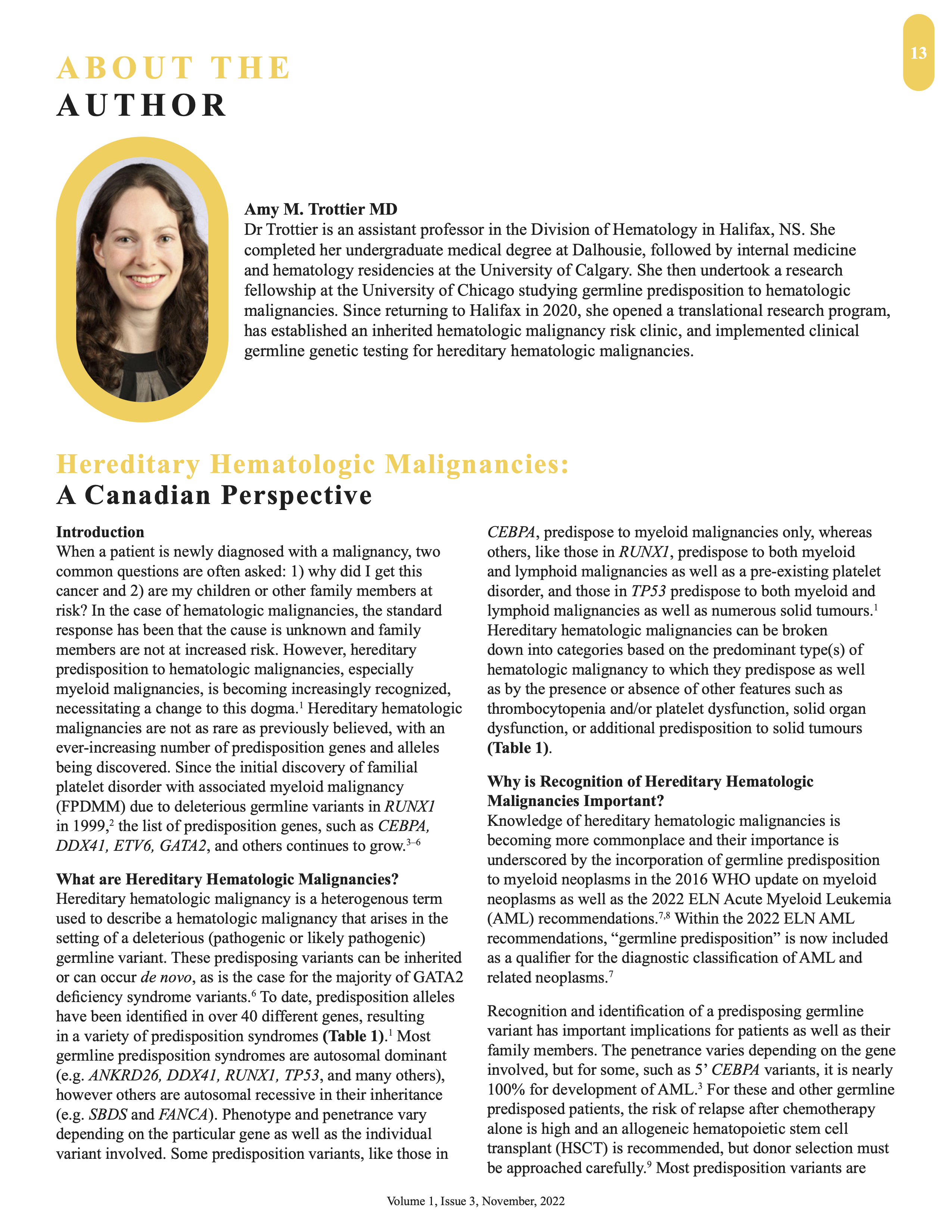Hereditary hematologic malignancies: a Canadian perspective
DOI:
https://doi.org/10.58931/cht.2022.1319Abstract
When a patient is newly diagnosed with a malignancy, two common questions are often asked: 1) why did I get this cancer and 2) are my children or other family members at risk? In the case of hematologic malignancies, the standard response has been that the cause is unknown and family members are not at increased risk. However, hereditary predisposition to hematologic malignancies, especially myeloid malignancies, is becoming increasingly recognized, necessitating a change to this dogma. Hereditary hematologic malignancies are not as rare as previously believed, with an ever-increasing number of predisposition genes and alleles being discovered. Since the initial discovery of familial platelet disorder with associated myeloid malignancy (FPDMM) due to deleterious germline variants in RUNX1 in 1999, the list of predisposition genes, such as CEBPA, DDX41, ETV6, GATA2, and others continues to grow.
References
Trottier AM, Godley LA. Inherited predisposition to haematopoietic malignancies: overcoming barriers and exploring opportunities. Br J Haematol. 2021;194(4):663-676. DOI: https://doi.org/10.1111/bjh.17247
Song W-J, Sullivan MG, Legare RD, et al. Haploinsufficiency of CBFA2 causes familial thrombocytopenia with propensity to develop acute myelogenous leukaemia. Nat Genet. 1999;23:166-175. Accessed November 12, 2017. http://www.nature.com.ezproxy.lib.ucalgary.ca/articles/ng1099_166.pdf DOI: https://doi.org/10.1038/13793
Tawana K, Wang J, Renneville A, et al. Disease evolution and outcomes in familial AML with germline CEBPA mutations. Blood. 2015;126(10):1214-1223. DOI: https://doi.org/10.1182/blood-2015-05-647172
Polprasert C, Schulze I, Sekeres MA, et al. Inherited and Somatic Defects in DDX41 in Myeloid Neoplasms. Cancer Cell. 2015;27(5):658-670. DOI: https://doi.org/10.1016/j.ccell.2015.03.017
Zhang MY, Churpek JE, Keel SB, et al. Germline ETV6 mutations in familial thrombocytopenia and hematologic malignancy. Nat Genet. 2015;47(2):180-185. DOI: https://doi.org/10.1038/ng.3177
Wlodarski MW, Collin M, Horwitz MS. GATA2 deficiency and related myeloid neoplasms. Semin Hematol. 2017;54(2):81-86. DOI: https://doi.org/10.1053/j.seminhematol.2017.05.002
Döhner H, Wei AH, Appelbaum FR, et al. Diagnosis and Management of AML in Adults: 2022 ELN Recommendations from an International Expert Panel. Blood. Published online July 7, 2022. DOI: https://doi.org/10.1182/blood.2022016867
Arber DA, Orazi A, Hasserjian R, et al. The 2016 revision to the World Health Organization classification of myeloid neoplasms and acute leukemia. Blood. 2016;127(20):2391-2405. DOI: https://doi.org/10.1182/blood-2016-03-643544
Trottier AM, Bannon S, Bashir Q, Carraway HE, Hofmann I, Godley LA. When should transplant physicians think about familial blood cancers? Adv Cell Gene Ther. 2019;2(4). DOI: https://doi.org/10.1002/acg2.68
Rojek K, Nickels E, Neistadt B, et al. Identifying Inherited and Acquired Genetic Factors Involved in Poor Stem Cell Mobilization and Donor-Derived Malignancy. Biol Blood Marrow Transplant. 2016;22(11):2100-2103. DOI: https://doi.org/10.1016/j.bbmt.2016.08.002
Buijs A, Poddighe P, Wijk R van, et al. A novel CBFA2 single-nucleotide mutation in familial platelet disorder with propensity to develop myeloid malignancies. Blood. 2001;98(9):2856-2858. DOI: https://doi.org/10.1182/blood.V98.9.2856
Hertenstein B, Hambach L, Bacigalupo A, et al. Development of leukemia in donor cells after allogeneic stem cell transplantation–a survey of the European Group for Blood and Marrow Transplantation (EBMT). Haematologica. 2005;90(7):969-975.
University of Chicago Hematopoietic Malignancies Cancer Risk Team TU of CHMCR. How I diagnose and manage individuals at risk for inherited myeloid malignancies. Blood. 2016;128(14):1800-1813. DOI: https://doi.org/10.1182/blood-2016-05-670240
Spinner MA, Sanchez LA, Hsu AP, et al. GATA2 deficiency: a protean disorder of hematopoiesis, lymphatics, and immunity. Blood. 2014;123(6):809-821. DOI: https://doi.org/10.1182/blood-2013-07-515528
Agarwal S. Evaluation and Management of Hematopoietic Failure in Dyskeratosis Congenita. Hematol Oncol Clin North Am. 2018;32(4):669-685. DOI: https://doi.org/10.1016/j.hoc.2018.04.003
Savage SA, Niewisch MR. Dyskeratosis Congenita and Related Telomere Biology Disorders. Adam MP, Ardinger HH, Pagon RA, et al., eds. GeneReviews® [Internet]. Published online March 31, 2022. Accessed August 16, 2022. https://www.ncbi.nlm.nih.gov/books/NBK22301/ DOI: https://doi.org/10.1182/hematology.2022000394
Deuitch N, Broadbridge E, Cunningham L, Liu P. RUNX1 Familial Platelet Disorder with Associated Myeloid Malignancies. Adam MP, Ardinger HH, Pagon RA, et al., eds. GeneReviews® [Internet]. Published online May 6, 2021. Accessed August 16, 2022. https://www.ncbi.nlm.nih.gov/books/NBK568319/
Churpek JE, Smith-Simmer K. DDX41-Associated Familial Myelodysplastic Syndrome and Acute Myeloid Leukemia. GeneReviews® [Internet]. Published online October 28, 2021. Accessed August 16, 2022. https://www.ncbi.nlm.nih.gov/books/NBK574843/
Godley LA, Shimamura A. Genetic predisposition to hematologic malignancies: management and surveillance. Blood. 2017;130(4):424-432. DOI: https://doi.org/10.1182/blood-2017-02-735290
Feurstein S, Churpek JE, Walsh T, et al. Germline variants drive myelodysplastic syndrome in young adults. Leukemia. 2021;35(8):2439. DOI: https://doi.org/10.1038/s41375-021-01137-0
Sébert M, Passet M, Raimbault A, et al. Germline DDX41 mutations define a significant entity within adult MDS/AML patients. Blood. 2019;134(17):1441-1444. DOI: https://doi.org/10.1182/blood.2019000909
Wan Z, Han B. Clinical features of DDX41 mutation-related diseases: a systematic review with individual patient data. Ther Adv Hematol. 2021;12. DOI: https://doi.org/10.1177/20406207211032433
Feurstein SK, Trottier AM, Estrada-Merly N, et al. Germline predisposition variants occur in myelodysplastic syndrome patients of all ages. Blood. 2022 Aug 18;140(24):2533-2548. DOI: https://doi.org/10.1182/blood.2022015790
Srivastava A, Giangiobbe S, Kumar A, et al. Identification of Familial Hodgkin Lymphoma Predisposing Genes Using Whole Genome Sequencing. Front Bioeng Biotechnol. 2020;8:179. DOI: https://doi.org/10.3389/fbioe.2020.00179
Pertesi M, Went M, Hansson M, Hemminki K, Houlston R, Nilsson B. Genetic predisposition for multiple myeloma. Leukemia. 2020;34(3):697-708. DOI: https://doi.org/10.1038/s41375-019-0703-6
Richards S, Aziz N, Bale S, et al. Standards and guidelines for the interpretation of sequence variants: a joint consensus recommendation of the American College of Medical Genetics and Genomics and the Association for Molecular Pathology. Genet Med. 2015;17(5):405-424. DOI: https://doi.org/10.1038/gim.2015.30

Published
How to Cite
Issue
Section
License
Copyright (c) 2022 Canadian Hematology Today

This work is licensed under a Creative Commons Attribution-NonCommercial-NoDerivatives 4.0 International License.
